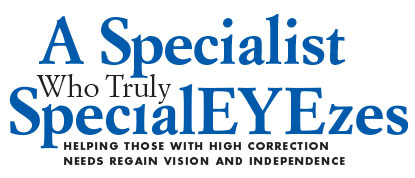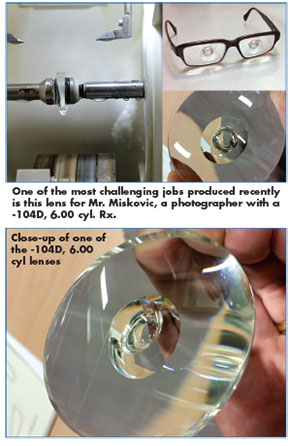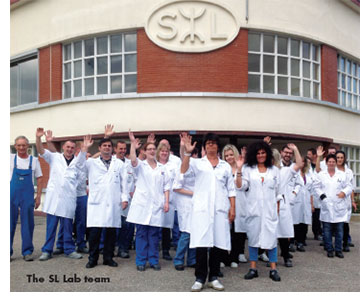

 Meet Leonel Pereira, the workshop manager for surfacing and special lenses at the SL Lab, Essilor’s “specials lab” in Ligny-en-Barrois, a town in the French province of Lorraine, in eastern France. Actually, the term “extra-special” might be more apt, since the one-of-a-kind lenses this lab makes restore vision to people suffering from very strong ametropias.
Meet Leonel Pereira, the workshop manager for surfacing and special lenses at the SL Lab, Essilor’s “specials lab” in Ligny-en-Barrois, a town in the French province of Lorraine, in eastern France. Actually, the term “extra-special” might be more apt, since the one-of-a-kind lenses this lab makes restore vision to people suffering from very strong ametropias.
“The SL Lab is incredible in that every day, we’re challenged to make unique lenses for out-of-the-ordinary visual needs,” says Pereira, whose in-depth technical knowledge of optics and production comes from 20 years’ experience with Essilor working alongside experts and exceptional lens craftsmen and women.
Producing specials is an important aspect of Essilor’s mission to promote visual health. It has a history and tradition within Essilor, and the SL lab operates on a site which has served as the training ground for Essilor’s optics experts since 1873, when calculations were prepared on graph paper. It’s not uncommon for technicians at the lab to have had a parent working on special lenses before them.
The SL Lab has 91 employees, 80 of whom work on Rx lenses. The lab was completely reconfigured during 2014 using lean-manufacturing principles that have resulted in greater efficiencies. It was renamed the Special Lenses Laboratory, or SL Lab. The name was deliberately chosen to recall “Société des Lunetiers” (SL), one of the ancestors of the Essilor Group. The SL Lab aims to double its special lenses production within three years, thanks to a strategy in three areas: developing expansion internationally, accelerating the development of new products and expanding the existing product range.
Poor vision is the world’s most widespread disability, affecting two-thirds of the global population, according to Essilor. Designing and making products that bring better sight, whatever the complexity of a person’s needs, is the basis of Essilor’s mission. The SL Lab enables Essilor to help people suffering from extreme vision difficulties to regain clear vision and often their independence.
—Andrew Karp
Pereira: Being part of the SL Lab team requires a lot of skills, but those that we particularly value when recruiting are not necessarily linked to a specific training. Our people come from a variety of backgrounds. Of course, we require a certain level of education (a high school degree), but above all, we look for more innate qualities, such as rigor, attention to detail, manual dexterity, the capacity to challenge oneself and one’s ideas, and personal motivation.In recent years, we’ve had to rise to the challenge of a wave of people retiring. It’s often a moment that’s difficult for an organization to manage. For us, it was an additional source of stimulus. Thanks to a series of planned mentored trainings in the workshop, we’ve succeeded in building a special lenses team with an average age of 35 who’ve already been with us for an average of 3.5 years. A real force for the future!
The only really effective way to train is through “buddying.” To be fully autonomous on every workstation, each operator needs full-time training with an experienced buddy over two years. It’s been a huge challenge as 90 percent of the team has changed over the past three years. Today we have a very motivated and committed team, proud to be restoring vision for people with very high correction needs.
Describe the process for designing a lens produced at SL. Do you begin with conventional lens designs and then modify them, or is each lens designed from scratch?
To understand the process of making special lenses, you need to understand the way we work. The production of a lens is how we achieve the optimal result for the end-user, and obviously we use every manufacturing technique available—traditional and digital—to achieve the best optics solution. Sometimes it takes up to six different lenses to create one special lens. For that reason, there is no pre-defined process to follow. Each need is unique, so each lens we produce is unique.
Our process is adapted to how we need to make the lens and not vice versa. Behind each lens is a real technical and industrial prowess, drawing on the craftsmanship of our lens makers using the most sophisticated technologies.
 How does SL use nanotechnology to create lenses?
How does SL use nanotechnology to create lenses?
The manufacturing of special lenses requires expertise in special surfacing, with an in-depth knowledge of machining tools, sometimes very old tools, which are essential for obtaining the extreme lens powers that we make. Digital surfacing technology is often used as well. Our special lenses benefit from the latest surface treatments, nanotechnologies used for anti-reflective UV, and photoselective filters, for example, to protect against the harmful effects of blue-violet light. These lenses can also be colored with therapeutic tints to help the wearer regain clear vision and better contrasts.
How do you determine what the patient’s needs are?
Each special lens is produced according to individual parameters taken in advance by our optician clients and sent to us for feasibility analysis. This enables opticians to demonstrate their knowledge, skill and added-value to wearers. We work in partnership, with complementary roles and a high level of expertise in our respective fields.
In certain cases and depending on functional needs or prescription measurements, we offer customized solutions to our client. This is often for very specific cases linked to ergonomy or precision vision required for certain activities, for example, archery, diving, flying, etc.
How do you incorporate the patient’s feedback in the lens design process? What sort of questions do you ask? What do you want to know? For example, how do you find out what solutions the patient has tried for their visual problems, how well it worked and what problems the patient encountered?
Client feedback is a goldmine of information for us, and we are always eager and impatient for it. We systematically discuss this in team meetings. We are in regular discussion with quality and customer satisfaction teams. They have a key role in analyzing client data and information that comes back from the field to define follow-up or action plans if necessary to improve the quality of our products.
Does SL use conventional lens processing equipment and techniques, or do you modify equipment to fit your needs? Do you ever make your own equipment or invent your own processes to suit your unique requirements?
Our lens making equipment has been modified to go beyond standard capacities. It’s a constant evolution, from the design of a new product or a single order through overcoming the technical barriers we may come up against. All the time we’re thinking of how to go further. For example, the special lenses team recently pushed optics limits, going beyond the previous industry record of 76 diopters to make a -104D, 6.00 cylinder lens for Mr. Miskovic, a wearer in the Slovak Republic who we met on World Sight Day in October. To achieve this exceptional lens power, new machining tools were created. We had to modify and remake specific tools, with a radius of around 8 mm, whilst rethinking how to make the lens in order to limit aberrations and approximations. To create the lens power across four sides, we had to calculate the total power and manufacture one side before applying the remaining power on the other, using a radiuscope to ensure accuracy of each side. Several days’ technical and commercial expertise were needed to fulfill this special lens order, as is the case with many others.
Producing this lens was an amazing challenge for the team, and we were delighted to receive a few weeks later a photograph of Mr. Miskovic happily wearing his new lenses. That’s a great example of the pride we get from the work we do. ■
Watch this video to learn more about the SL lab: youtube.com/watch?v=IL0CshpHL04
This video explains how Mr. Miskovic benefitted from and the unique -104D, 6.00 cylinder lens created for him by the SL Lab: youtube.com/watch?v=6jT-9aD6_wk










